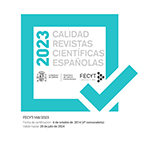La imagen negada Mito e ideología en la imagen de la persona con VIH
Resumen
Este artículo se centra en aquellos aspectos mitológicos e ideológicos que afectan a la imagen de la persona que vive con el virus de inmunodeficiencia humana (VIH) y su incidencia en la producción de audiovisuales destinados a formar parte de programas de prevención de esta enfermedad en jóvenes. La dualidad imagen- no-imagen constituye un binomio fundamental para el estudio del papel que desempeña la imagen técnica como elemento de identidad y formación de mito en la persona que vive con VIH y, consecuentemente, para articular obras de prevención sustentadas en narrativas audiovisuales del género documental.
Se parte de un estudio cualitativo basado en un conjunto de testimonios recogidos en forma de entrevista a personas con VIH en El Salvador y España. El material registrado en formatos vídeo y audio comprende un total de 27 entrevistas de larga duración (entre 60 y 90 minutos por término medio), que sirvieron de fuente de información y documentación para la realización del documental Yo soy positivo ¿y tú?, película destinada a la prevención del VIH en la población joven de ambos países. La reflexión parte de la decisión tomada por cada uno de los entrevistados de hacer o no visible su condición de seropositivo, así como del tratamiento audiovisual que se consideró más apropiado y posible con fines preventivos. Se analiza la relación signo- no signo de una realidad que puja por hacerse visible y que se debate entre la ciencia y el mito.
Descargas
Descarga artículo
Licencia
La revista Política y Sociedad, para fomentar el intercambio global del conocimiento, facilita el acceso sin restricciones a sus contenidos desde el momento de su publicación en la presente edición electrónica, y por eso es una revista de acceso abierto. Los originales publicados en esta revista son propiedad de la Universidad Complutense de Madrid y es obligatorio citar su procedencia en cualquier reproducción total o parcial. Todos los contenidos se distribuyen bajo una licencia de uso y distribución Creative Commons Reconocimiento 4.0 (CC BY 4.0). Esta circunstancia ha de hacerse constar expresamente de esta forma cuando sea necesario. Puede consultar la versión informativa y el texto legal de la licencia.











